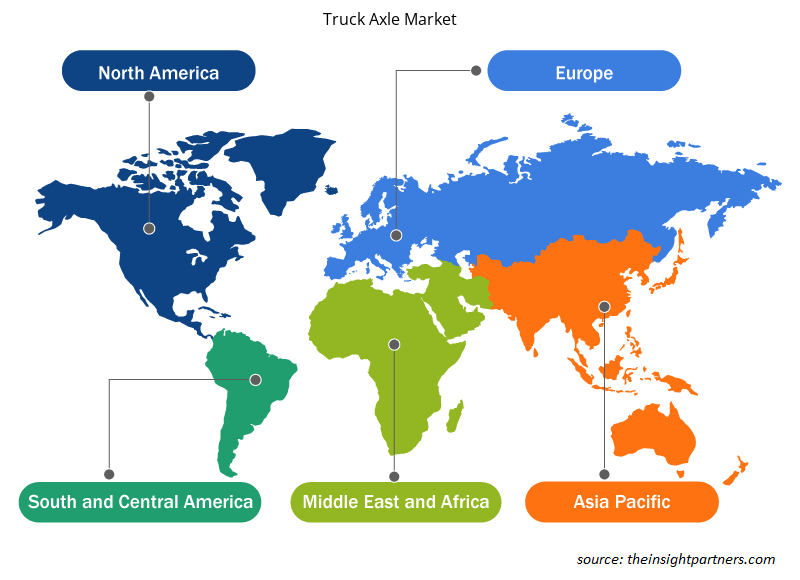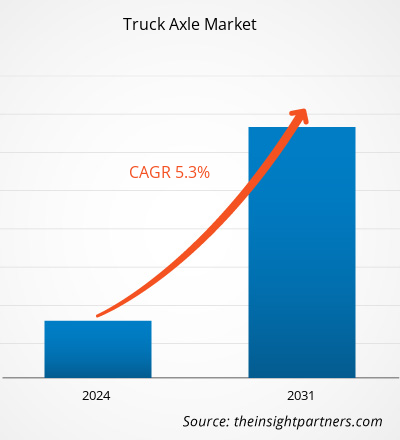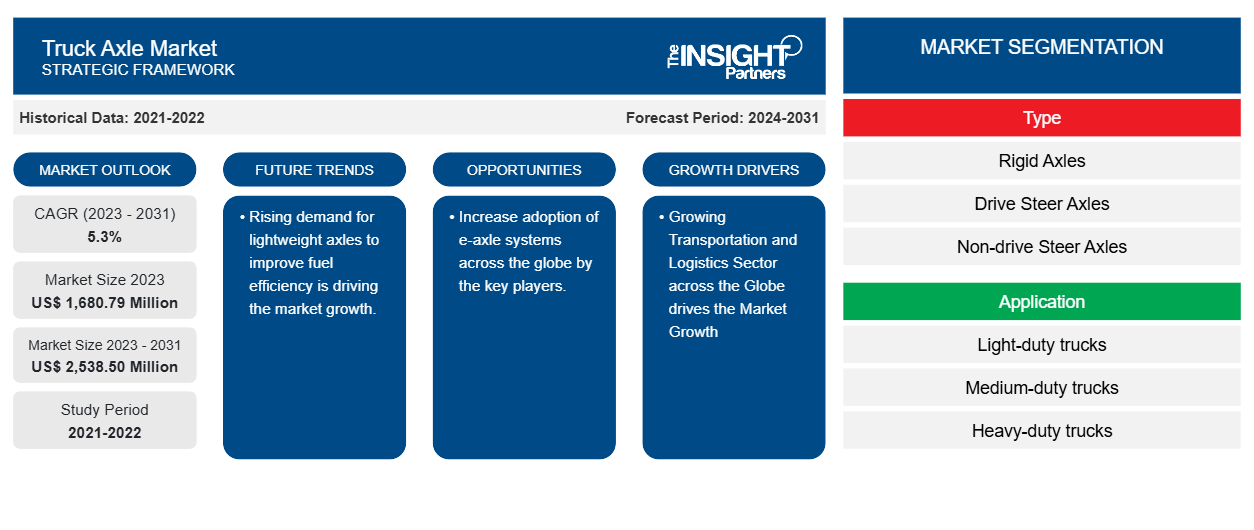Se proyecta que el tamaño del mercado de ejes para camiones alcance los 2.538,50 millones de dólares en 2031, frente a los 1.680,79 millones de dólares en 2023. Se espera que el mercado registre una CAGR del 5,3 % durante el período 2023-2031. La creciente adopción del transporte conectado en todo el mundo está impulsando la tendencia en el mercado. La creciente demanda de ejes ligeros para mejorar la eficiencia del combustible está impulsando el crecimiento del mercado.
Análisis del mercado de ejes para camiones
El aumento de las ventas de vehículos comerciales, junto con el aumento de las actividades de logística y transporte y el aumento de la industria del comercio electrónico, impulsan el crecimiento del mercado de ejes para camiones durante el período de pronóstico. El aumento de las ventas de camiones comerciales de servicio pesado en los países de Asia Pacífico, como India, China, Japón y Corea del Sur, impulsa el crecimiento del mercado.
Descripción general del mercado de ejes para camiones
El eje del camión es un componente esencial de los vehículos comerciales pesados. Estos ejes de camión ayudan a entregar fuerza motriz a las ruedas de los vehículos. Estos ejes soportan toda la carga del vehículo. Los camiones pesados requieren ejes rígidos para soportar un peso pesado. El aumento de las ventas de vehículos comerciales pesados en todo el mundo está impulsando el crecimiento del mercado de ejes de camiones durante el período de pronóstico. Según la Asociación de Automóviles de Pasajeros de China, en abril de 2024, se vendieron alrededor de 44.000 camionetas en China. Las ventas de camionetas en China aumentaron un 4,4% interanual en abril de 2024 en comparación con abril de 2023. Tal crecimiento en la venta de camiones en China impulsa el crecimiento del mercado de ejes de camiones durante el período de pronóstico.
Personalice este informe según sus necesidades
Obtendrá personalización en cualquier informe, sin cargo, incluidas partes de este informe o análisis a nivel de país, paquete de datos de Excel, así como también grandes ofertas y descuentos para empresas emergentes y universidades.
-
Obtenga las principales tendencias clave del mercado de este informe.Esta muestra GRATUITA incluirá análisis de datos, desde tendencias del mercado hasta estimaciones y pronósticos.
Factores impulsores y oportunidades del mercado de ejes para camiones
El crecimiento del sector del transporte y la logística en todo el mundo impulsa el crecimiento del mercado.
El sector del transporte es un sector industrial importante que se ocupa del movimiento de bienes, personas y productos. El sector del transporte está creciendo a un ritmo rápido debido al aumento del sector del comercio electrónico que impulsa el crecimiento del mercado. Según la Oficina de Estadísticas de Transporte, el valor neto de la infraestructura de transporte, incluidos los vehículos y el equipo, se valoró en 10,68 billones de dólares estadounidenses en 2022. El sector del transporte del sector público está valorado en 5,96 billones de dólares estadounidenses y el sector privado en 4,71 billones de dólares estadounidenses. Este crecimiento en el sector del transporte en todo el mundo impulsa el crecimiento del mercado de ejes para camiones durante el período de pronóstico.
Aumentar la adopción de sistemas de ejes eléctricos en todo el mundo por parte de los actores clave.
Los ejes eléctricos se adoptan ampliamente en sistemas de propulsión electromecánicos que están equipados con estructura de eje, electrónica de potencia, un motor eléctrico y transmisión. Este dispositivo ofrece soluciones de propulsión eléctrica rentables para camiones eléctricos puros y camiones híbridos. Además, en combinación con sistemas de energía híbridos y de combustión interna, se utiliza un eje eléctrico. Los fabricantes de camiones eléctricos están adoptando motores eléctricos en sus ejes traseros rígidos para reducir el peso del vehículo . Esto es esencial para mejorar la eficiencia de los camiones eléctricos. El sistema de eje eléctrico se instala en la suspensión existente que permite la eliminación de los sistemas de propulsión. El principal factor impulsor del eje eléctrico en los camiones es el aumento de las ventas globales de camiones eléctricos e híbridos con el aumento de los costos del combustible.electromechanical propulsion systems that are equipped with shaft structure, power electronics, an electric motor and transmission. This device offers cost-effective electric propulsion solutions for pure electric trucks and hybrid trucks. Furthermore, in combination with ICE and hybrid power systems, an e-axle is used. Electric truck manufacturers are adopting electric motors into their rigid rear axles to reduce the weight of the
Análisis de segmentación del informe de mercado de ejes de camiones
Los segmentos clave que contribuyeron a la derivación del análisis del mercado de ejes de camiones son el tipo, la aplicación y la geografía.
- Según el tipo, el mercado se divide en ejes rígidos, ejes de dirección motriz y ejes de dirección no motrices. Entre estos, se espera que los ejes rígidos tengan la mayor participación en 2023. Esto se debe a la creciente demanda de vehículos comerciales pesados.
- Según la aplicación, el mercado se divide en camiones ligeros, camiones medianos y camiones pesados. Entre estos, se espera que los camiones pesados tengan la mayor participación en 2023. Esto se debe al aumento de las ventas de camiones pesados comerciales en todo el mundo.
Análisis de la cuota de mercado de ejes de camiones por geografía
El alcance geográfico del informe del mercado de ejes de camiones se divide principalmente en cinco regiones: América del Norte, Asia Pacífico, Europa, Medio Oriente y África, y América del Sur y Central.
Se espera que Asia Pacífico tenga la mayor participación en el mercado de ejes para camiones debido al aumento de la demanda y la venta de camiones en países en desarrollo como China, India y Japón. Las ventas de camiones en la región de Asia Pacífico alcanzaron los 2,67 millones de unidades en 2024. Este crecimiento en las ventas de camiones en China, India y Japón impulsó el crecimiento del mercado de ejes para camiones durante el período de pronóstico. La región de Asia Pacífico tiene una participación significativa de alrededor del 50,4% del mercado mundial de camiones pesados. Esto crea una amplia oportunidad para el crecimiento del mercado de ejes para camiones durante el período de pronóstico.
Perspectivas regionales del mercado de ejes para camiones
Los analistas de Insight Partners explicaron en detalle las tendencias y los factores regionales que influyen en el mercado de ejes para camiones durante el período de pronóstico. Esta sección también analiza los segmentos y la geografía del mercado de ejes para camiones en América del Norte, Europa, Asia Pacífico, Oriente Medio y África, y América del Sur y Central.

- Obtenga datos regionales específicos para el mercado de ejes de camiones
Alcance del informe sobre el mercado de ejes para camiones
| Atributo del informe | Detalles |
|---|---|
| Tamaño del mercado en 2023 | US$ 1.680,79 millones |
| Tamaño del mercado en 2031 | US$ 2.538,50 millones |
| CAGR global (2023 - 2031) | 5,3% |
| Datos históricos | 2021-2022 |
| Período de pronóstico | 2024-2031 |
| Segmentos cubiertos |
Por tipo
|
| Regiones y países cubiertos |
América del norte
|
| Líderes del mercado y perfiles de empresas clave |
|
Densidad de actores del mercado de ejes para camiones: comprensión de su impacto en la dinámica empresarial
El mercado de ejes para camiones está creciendo rápidamente, impulsado por la creciente demanda de los usuarios finales debido a factores como la evolución de las preferencias de los consumidores, los avances tecnológicos y una mayor conciencia de los beneficios del producto. A medida que aumenta la demanda, las empresas amplían sus ofertas, innovan para satisfacer las necesidades de los consumidores y aprovechan las tendencias emergentes, lo que impulsa aún más el crecimiento del mercado.
La densidad de actores del mercado se refiere a la distribución de las empresas o firmas que operan dentro de un mercado o industria en particular. Indica cuántos competidores (actores del mercado) están presentes en un espacio de mercado determinado en relación con su tamaño o valor total de mercado.
Las principales empresas que operan en el mercado de ejes para camiones son:
- Eje y fabricación americanos, Inc.
- Dana limitada
- Compañía Meritor, Inc.
- Grupo Qingte Co., Ltd.
- Sociedad Anónima Raba Automotive Holding Plc.
- SAF-HOLANDA SE
Descargo de responsabilidad : Las empresas enumeradas anteriormente no están clasificadas en ningún orden particular.

- Obtenga una descripción general de los principales actores clave del mercado de ejes para camiones
Noticias y novedades sobre el mercado de ejes para camiones
El mercado de ejes para camiones se evalúa mediante la recopilación de datos cualitativos y cuantitativos posteriores a la investigación primaria y secundaria, que incluye publicaciones corporativas importantes, datos de asociaciones y bases de datos. A continuación, se enumeran algunos de los desarrollos en el mercado de ejes para camiones:
- Ashok Leyland ha lanzado un nuevo camión con eje elevador de neumáticos doble (DTLA) de 3 ejes 6×2, el AVTR 3120. Con este lanzamiento, Ashok Leyland se convierte en el primer y único actor del país en tener una gama completa de camiones DTLA con nodos de GVW de 31T, 40,5T y 47,5T. (Fuente: Fuente: Comunicado de prensa, diciembre de 2021)
- ReFuels NV, uno de los principales proveedores europeos de biometano renovable (Bio-CNG) para la descarbonización de vehículos pesados, anuncia hoy que Scania UK ha lanzado un nuevo camión de GNC de tres ejes (6×2), lo que aumenta significativamente el mercado potencial para incluir la clase de vehículo preferida por los operadores de flotas del Reino Unido. (Fuente: Comunicado de prensa, junio de 2024)
Informe sobre el mercado de ejes para camiones: cobertura y resultados
El informe “Tamaño y pronóstico del mercado de ejes para camiones (2021-2031)” proporciona un análisis detallado del mercado que cubre las siguientes áreas:
- Tamaño del mercado de ejes de camiones y pronóstico a nivel mundial, regional y nacional para todos los segmentos clave del mercado cubiertos bajo el alcance
- Tendencias del mercado de ejes para camiones, así como dinámicas del mercado, como impulsores, restricciones y oportunidades clave
- Análisis PEST y FODA detallados
- Análisis del mercado de ejes de camiones que cubre las tendencias clave del mercado, el marco global y regional, los principales actores, las regulaciones y los desarrollos recientes del mercado.
- Análisis del panorama de la industria y de la competencia que abarca la concentración del mercado, el análisis de mapas de calor, los actores destacados y los desarrollos recientes del mercado de ejes para camiones
- Perfiles detallados de empresas
- Análisis histórico (2 años), año base, pronóstico (7 años) con CAGR
- Análisis PEST y FODA
- Tamaño del mercado, valor/volumen: global, regional y nacional
- Industria y panorama competitivo
- Conjunto de datos de Excel
Informes recientes
Informes relacionados
Testimonios
Razón para comprar
- Toma de decisiones informada
- Comprensión de la dinámica del mercado
- Análisis competitivo
- Información sobre clientes
- Pronósticos del mercado
- Mitigación de riesgos
- Planificación estratégica
- Justificación de la inversión
- Identificación de mercados emergentes
- Mejora de las estrategias de marketing
- Impulso de la eficiencia operativa
- Alineación con las tendencias regulatorias























 Obtenga una muestra gratuita para - Mercado de ejes para camiones
Obtenga una muestra gratuita para - Mercado de ejes para camiones